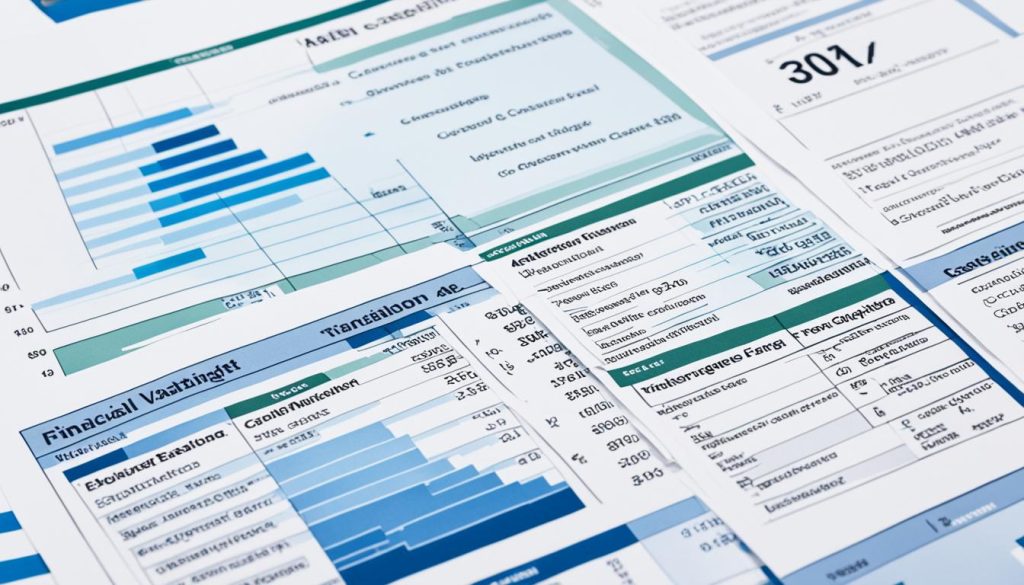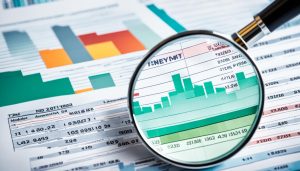Valuing a wealth management firm is a complex process that requires a deep understanding of its tangible and intangible assets. By accurately assessing these assets, you can determine the true value of the company and make informed financial decisions. In this article, we will explore the methods and techniques used to value wealth management firms, helping you gain the expertise needed to navigate this crucial aspect of the financial industry.
Key Takeaways:
- Valuing a wealth management firm requires assessing both tangible and intangible assets.
- Tangible assets include fixed assets and current assets.
- Intangible assets include patents, logos, and trademarks.
- Methods for valuing assets include the cost method, market value method, base stock method, and standard cost method.
- Accurate asset valuation is essential for determining the right price, facilitating mergers, loan applications, and ensuring compliance with audit processes.
Valuing Tangible Assets
Tangible assets play a vital role in the valuation of a company. These are physical assets that a company owns and utilizes to produce goods or services. Examples of tangible assets include structures, land, machinery, vehicles, and IT equipment.
When valuing tangible assets, it is crucial to calculate the net tangible assets of a company accurately. This can be done by subtracting the total value of intangible assets and liabilities from the total assets. The result obtained from this calculation is known as the net asset value or net tangible assets.
Net tangible assets give investors and stakeholders a clear understanding of the tangible value a company holds. It provides insights into the company’s financial health and the value of its physical assets. By assessing the net tangible assets, investors can gauge the financial stability and growth potential of the company.
In order to accurately value tangible assets, various tangible asset valuation methods can be used. These methods include the cost method, market value method, base stock method, and standard cost method. The choice of valuation method depends on the specific circumstances, such as the industry and the nature of the assets being valued.
The cost method involves valuing assets based on their historical purchase price. The market value method, on the other hand, takes into account the asset’s current market price or projected price in the open market. The base stock method evaluates the value of stocks based on a base stock, while the standard cost method utilizes the expected costs of assets based on past experience.
Each of these tangible asset valuation methods provides unique insights and perspectives, enabling a comprehensive assessment of tangible assets. By leveraging these methods, businesses and investors can make informed financial decisions and accurately determine the value of tangible assets.
Valuing tangible assets is a critical component of company valuation. By understanding the methods and calculations involved, individuals can gain a deeper insight into the financial standing and potential of a company, leading to informed decision-making.
Valuing Intangible Assets
Intangible assets play a crucial role in determining the overall value of a company. Unlike tangible assets, such as buildings or machinery, intangible assets have no physical form but provide future benefits to the organization. These assets can include patents, logos, franchises, and trademarks.
The importance of valuing intangible assets cannot be overstated. Even when tangible assets are no longer present, intangible assets can still contribute significantly to the value of a company. Properly assessing and valuing these assets is essential for accurate financial reporting and decision-making.
Valuing intangible assets can be more complex than valuing tangible assets, primarily because there is no historical cost to rely on. However, various methods can be employed to determine their worth. One approach is to consider the market value of similar intangible assets that have recently been sold. Another method involves estimating the replacement value of the asset if it were to be recreated today.
Valuing intangible assets is a critical aspect of business valuation. It allows companies to assess their intellectual property and brand value, which can directly impact their competitiveness in the market.
The advent of the digital age has made intangible assets increasingly valuable. Companies with strong intellectual property portfolios and recognized brands often command higher valuations in the market. This emphasizes the need for accurate intangible asset valuation methods.
Methods for Valuing Intangible Assets
Several valuation methods exist for assessing the worth of intangible assets. One widely used method is the income approach, which estimates the present value of the asset based on projected future cash flows it is expected to generate. Another method, the cost approach, considers the historical cost of creating or acquiring the asset as a basis for valuation.

Additionally, the market approach involves comparing the asset to similar assets that have recently been sold to determine its fair market value. It is essential to consider the specific characteristics of the asset and its market when selecting the most appropriate valuation method.
Importance of Intangible Assets in Valuation
Valuing intangible assets is of paramount importance in accurately assessing the overall value of a company. These intangible assets, such as patents, logos, franchises, and trademarks, can significantly contribute to the company’s competitive advantage and future profitability.
Properly valuing these assets allows businesses to make informed decisions about their intellectual property investments, brand strategies, and potential mergers or acquisitions. It also enables companies to report their assets accurately for financial reporting and compliance purposes.
In today’s knowledge-based economy, where innovation and intellectual property are key drivers of success, valuing intangible assets is an essential component of the valuation process.
Methods of Asset Valuation
Valuing assets is a critical process for wealth management firms. This involves determining the true worth of both tangible and intangible assets owned by the company. Several valuation methods can be employed in this process, each providing a unique perspective on asset valuation. Let’s delve into some of the most commonly used methods:
1. Cost Method
The cost method of asset valuation involves assessing assets based on their historical purchase price. This method is particularly useful for valuing tangible assets, such as buildings, machinery, and equipment. By considering the original cost, companies can determine the asset’s current value and include it in their valuation calculations.
2. Market Value Method
The market value method relies on the current market price of an asset or its projected price in the open market. This approach is commonly used for both tangible and intangible assets. By considering the prevailing market conditions and demand for similar assets, wealth management firms can gauge the market value of their assets accurately.
3. Base Stock Method
The base stock method is primarily used in the valuation of stocks. It involves assessing the value of stocks based on a fixed or base stock. By comparing the base stock value to the actual stock value, wealth management firms can determine the fluctuations in the stock’s worth over time.
4. Standard Cost Method
The standard cost method, also known as the expected cost method, relies on utilizing expected costs instead of actual costs based on past experience. It is commonly used in the valuation of assets with significant fluctuations in costs, such as raw materials or commodities. By considering the expected costs, companies can account for potential variations and estimate the true value of these assets.
These methods of asset valuation provide wealth management firms with valuable insights into the worth of their tangible and intangible assets. By employing a combination of these techniques, firms can make informed financial decisions, negotiate fair deals, and accurately represent the value of their assets.

Importance of Asset Valuation
Asset valuation plays a crucial role in various aspects of business. It serves as a valuable tool in determining the appropriate price for an asset during buying or selling transactions. By conducting a thorough valuation, parties involved can ensure that they neither overpay nor accept a discounted price. This process helps maintain fairness and transparency in financial dealings.
Furthermore, asset valuation holds immense significance during company mergers or takeovers. In these scenarios, accurately determining the true value of a business becomes essential for negotiation and decision-making. Valuing assets allows both parties to gain a clear understanding of the assets’ worth, enabling them to make well-informed choices about the future of the company.
When it comes to loan applications, asset valuation becomes a critical factor for lenders. They need to assess the value of assets to determine collateral for the loan. By understanding the true worth of the assets being offered as security, lenders can make informed decisions, mitigating the risk associated with lending.
“Asset valuation is not only about determining the financial value of assets. It is a process that enables businesses to understand their true worth and make strategic decisions based on accurate and reliable information.”
Moreover, publicly traded companies are required to present audited financial statements that include verified asset values. This ensures transparency and compliance with regulatory standards. By providing auditors and stakeholders with accurate asset values, businesses can establish trust and credibility, reinforcing their position in the market.
Overall, asset valuation plays a multifaceted role in business. It helps establish fair prices, facilitates mergers and takeovers, assists in loan applications, and ensures compliance with auditing standards. By valuing assets accurately, businesses can make informed financial decisions, enhance transparency, and maintain trust in the ever-evolving marketplace.

Key Takeaways:
- Asset valuation helps determine fair prices during buying or selling transactions, ensuring neither party overpays or accepts a discounted price.
- Valuing assets accurately is crucial during company mergers or takeovers, allowing both parties to determine the true value of the business.
- Lenders assess asset values when evaluating loan applications, helping determine collateral and manage risks.
- Public companies need audited financial statements with verified asset values to ensure transparency and compliance.
Conclusion
In conclusion, the valuation of a wealth management firm involves a comprehensive assessment of both its tangible and intangible assets. Various methods, such as the cost method, market value method, base stock method, and standard cost method, can be utilized to determine the value of tangible assets. On the other hand, valuing the intangible assets requires considering factors like market value and replacement value.
Accurate asset valuation plays a crucial role in determining the right price for a wealth management firm, enabling successful company mergers, facilitating loan applications, and ensuring compliance with audit processes. By understanding the true value of a firm, stakeholders can make informed financial decisions that align with their goals.
Key takeaways from wealth management firm valuation include the importance of considering both tangible and intangible assets, the utilization of diverse valuation methods, the impact of accurate valuation on financial decision-making, and the significant role asset valuation plays in various business processes.




No comments! Be the first commenter?